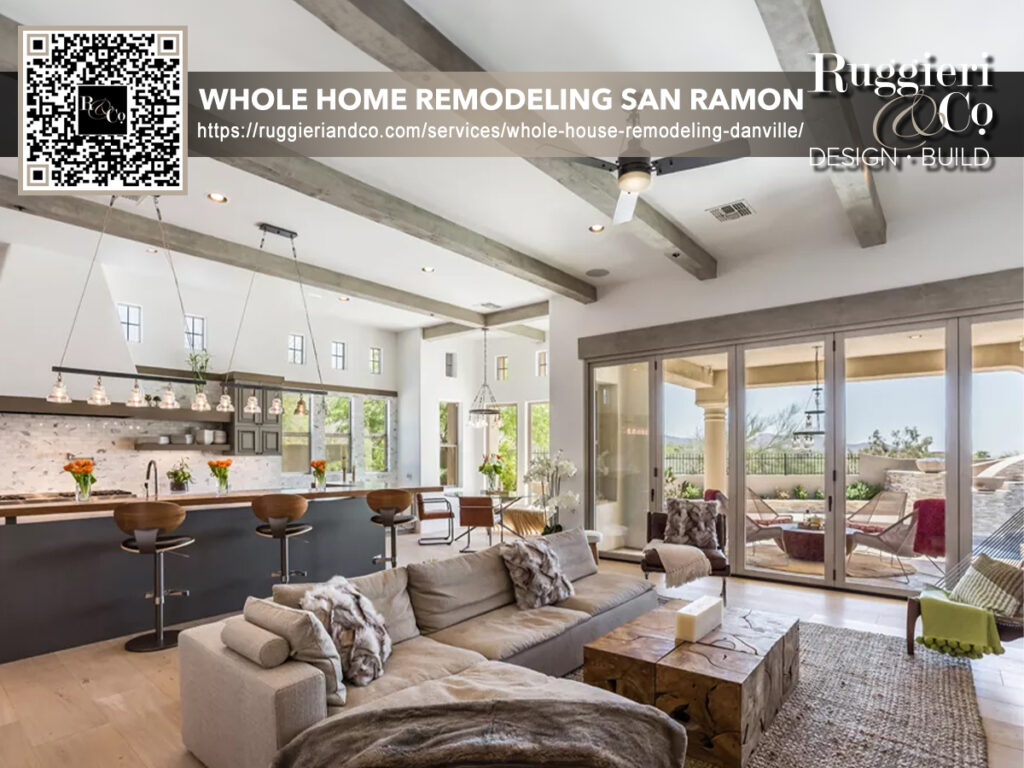When planning a whole house remodeling project, it is important to consider how to effectively design an open floor plan. An open floor plan can create a sense of space and connectivity throughout the home, making it more functional and visually appealing. In San Ramon, CA, many homeowners are opting for whole house remodels to achieve their desired open concept design. By following some expert interior design tips, you can successfully create an open floor plan that enhances your living space and improves the overall functionality of your home.
Key Takeaways:
- Designing an open floor plan can create a sense of space and connectivity in your home.
- Whole house remodeling in San Ramon, CA is a popular choice for achieving an open concept design.
- Expert interior design tips can help you effectively design an open floor plan.
- An open floor plan enhances the functionality and aesthetics of your home.
- Consider hiring a professional interior designer and reliable contractor for a successful whole house remodel.
Benefits of an Open Floor Plan in Whole House Remodeling
Designing an open floor plan in a whole house remodeling project offers numerous benefits. Firstly, it allows for better space optimization, as it eliminates unnecessary walls and creates a more fluid layout. This can make your home feel larger and more spacious. Additionally, an open floor plan promotes better social interaction and connectivity between rooms, allowing for easy flow and movement throughout the house. It also allows for better natural light penetration and improved sightlines. By incorporating an open floor plan design into your whole house remodel, you can maximize the potential of your living space and create a home that is both functional and visually appealing.
To illustrate the benefits of an open floor plan design, let’s take a look at a comparison between a traditional floor plan and an open floor plan:
| Traditional Floor Plan | Open Floor Plan |
|---|---|
| Limited natural light due to closed-off rooms | Ample natural light throughout the space |
| Restricted movement between rooms | Easy flow and connectivity between rooms |
| Less usable space due to walls and partitions | Optimized space utilization without unnecessary barriers |
| Poor sightlines and visibility | Improved sightlines and a sense of openness |
As the table demonstrates, an open floor plan design offers a range of advantages over a traditional floor plan. From increased natural light to enhanced room connectivity, the benefits of an open floor plan are evident. By embracing the concept of open space and eliminating unnecessary barriers, you can create a home that feels more spacious, inviting, and conducive to modern living.
Considerations for Designing an Open Floor Plan
When embarking on a whole house remodel to design an open floor plan, there are several crucial considerations to take into account. These considerations will ensure that your floor plan layout maximizes space, promotes efficient room connectivity, and creates a seamless open concept design that aligns with your style and preferences.
1. Optimize Floor Plan Layout
The first consideration is to carefully plan the layout of your floor plan to maximize space utilization and flow between rooms. This may involve reconfiguring walls, creating larger doorways, or adding archways to ensure a smooth transition from one area to another. A well-thought-out floor plan layout will enhance the overall functionality of your home and create a sense of openness.
2. Enhance Room Connectivity
An important aspect of designing an open floor plan is to promote efficient room connectivity. This can be achieved by strategically placing key elements such as furniture, fixtures, and architectural elements to create a seamless flow between rooms. By enhancing room connectivity, you will create a cohesive and harmonious living space where each area complements the others.
3. Create a Cohesive Open Concept
Consider how the open concept design will affect the overall aesthetics of your home. It is essential to ensure that the design aligns with your style and preferences while maintaining a cohesive look throughout the space. Selecting consistent materials, color palettes, and finishes will help create a unified and visually appealing open floor plan.
By carefully considering these key factors when designing your open floor plan, you can create a well-designed and cohesive living space that not only maximizes space and room connectivity but also reflects your unique style and enhances your overall living experience.
Space Planning in Whole House Remodeling
When undertaking a whole house remodel with an open floor plan, effective space planning is essential to optimize the functionality and flow of each room. By carefully considering the placement of furniture and fixtures, you can create a harmonious and well-utilized living environment. Here are some interior design tips for space planning in your open floor plan:
- Define designated areas: Create designated areas for different activities, such as living, dining, and kitchen spaces. This helps to establish a sense of purpose and organization within your open floor plan.
- Maximize open space: Maintain a sense of openness and connectivity by strategically placing furniture, leaving adequate space for easy movement and flow. Avoid overcrowding the rooms, as it can make the space feel cramped and hinder functionality.
- Consider room dividers: Incorporate room dividers or partitions to create visual separation and privacy in certain areas, while still maintaining the overall open concept. This can be achieved through the use of sliding doors, folding screens, or even bookshelves.
- Create multipurpose spaces: Make the most of your open floor plan by incorporating multipurpose spaces. For example, a kitchen island can serve as a cooking and dining area, or a home office can be integrated into a living space. This enhances the functionality of your home and optimizes space utilization.
- Promote natural flow: Ensure that there is a smooth flow and easy transition between different areas of your open floor plan. Consider the placement of doors, windows, and walkways to optimize the overall flow and connectivity.
By implementing these space planning strategies, you can create a well-designed open floor plan that maximizes space utilization, enhances functionality, and promotes a visually appealing living environment.
| Furniture Placement | Advantages |
|---|---|
| Arranged to create distinct zones | Clear separation of different areas within the open floor plan for better organization and functionality |
| Strategically positioned to allow for easy movement | Effortless flow between spaces, ensuring a sense of openness and connectivity |
| Utilize multifunctional furniture | Maximize space utilization with furniture that serves multiple purposes, such as storage ottomans or convertible sofas |
Space planning plays a crucial role in the success of an open floor plan design in a whole house remodel. By considering the function and flow of each room, incorporating designated areas, and utilizing strategic furniture placement, you can create a well-designed and functional living space. Learn more about How to Maximize Organization in Your Bathroom Remodel in San Ramon.
Maximizing Natural Light in an Open Floor Plan
One of the advantages of an open floor plan is its ability to maximize natural light in the home. When designing your whole house remodel, prioritizing natural light can significantly enhance the atmosphere and visual appeal of your living space. With strategic window placement and the incorporation of skylights, you can optimize natural light penetration, creating a bright and airy environment.
Strategically positioning windows is crucial for maximizing natural light in an open floor plan. Consider the orientation of your home and the location of rooms when determining window placement. Placing windows on opposite walls can allow for cross-ventilation and better light distribution. Additionally, incorporating larger windows in areas where natural light is most needed, such as the living room or kitchen, can create a focal point and flood the space with light.
Skylights can also be a game-changer for maximizing natural light in an open floor plan. By integrating skylights into your remodel, you can bring in an abundance of natural light from above, making the space feel even more open and expansive. Skylights are particularly effective in areas with limited wall space or where privacy might be a concern, such as bathrooms or walk-in closets.
When designing your open floor plan remodel, it’s essential to use light-colored walls and incorporate reflective surfaces to enhance the impact of natural light. Light-colored walls tend to reflect light better, making the space feel brighter and more spacious. You can also strategically place mirrors or glass elements to bounce natural light around the room, creating a sense of depth and openness.
Incorporating an effective window placement and skylights in your open floor plan can greatly enhance the overall aesthetic and functionality of your home. By maximizing natural light, you can create a visually pleasing and energy-efficient environment that promotes a positive and inviting atmosphere.
| Benefits of Maximizing Natural Light in an Open Floor Plan |
|---|
| 1. Enhanced brightness and spaciousness |
| 2. Energy efficiency and reduced reliance on artificial lighting |
| 3. Improved mood and well-being |
| 4. Highlighting architectural and design features |
| 5. Aesthetically pleasing and inviting space |
Balancing Privacy and Openness in an Open Floor Plan
While designing an open floor plan, it is crucial to strike a balance between connectivity and privacy. Although the open concept promotes a seamless flow of space, incorporating elements that provide privacy when needed is essential. By incorporating room dividers or partitions, you can create designated areas that offer privacy while maintaining a sense of openness and connectivity in your home.
There are various options for room dividers that can be seamlessly integrated into your open floor plan. Consider the following:
- Sliding doors: Sliding doors are a versatile choice that allows you to open up or close off areas as desired. They offer the flexibility to create private spaces while maximizing the overall open feel of the floor plan.
- Folding screens: Folding screens can be used to divide larger spaces into smaller, more intimate areas. They are easy to move and can be adjusted according to your privacy needs.
- Bookshelves: Bookshelves not only serve as storage but also act as decorative partitions. They provide an excellent opportunity to showcase your favorite books, accessories, and artwork while creating a visual barrier.
By carefully designing for privacy within your open floor plan, you can ensure that each area of your home serves its intended purpose without compromising the overall sense of connectedness.
Example of Room Dividers in an Open Floor Plan:
| Room Divider | Description | Advantages |
|---|---|---|
| Sliding Doors | Movable doors that slide along a track to open or close off spaces. | – Flexible and easy to adjust – Allows for the flow of natural light – Provides sound insulation |
| Folding Screens | Lightweight screens that can be folded and unfolded as needed. | – Portable and versatile – Can be easily customized – Adds a decorative element to the space |
| Bookshelves | Shelves that act as both storage and visual dividers. | – Offers additional storage space – Enhances the aesthetic appeal of the room – Provides a sense of privacy |
By incorporating well-designed room dividers, you can create a harmonious balance between privacy and openness in your open floor plan, ensuring that your home is both functional and aesthetically pleasing.
Choosing the Right Flooring for an Open Floor Plan
When designing an open floor plan, the choice of flooring is crucial to creating a cohesive and visually appealing space. It’s important to select flooring options that provide seamless transitions between different areas of your home, allowing for a unified and harmonious look. Among the various flooring materials available, hardwood floors are a popular choice for open floor plans.
Hardwood floors not only offer durability but also timeless beauty that adds warmth and elegance to any room. They provide a smooth and continuous flow throughout the space, enhancing the sense of openness and connectivity. With their natural grain patterns and rich tones, hardwood floors create a visually inviting atmosphere.
However, if hardwood floors don’t align with your budget or preferences, other flooring options can achieve a similar effect. Laminate or luxury vinyl planks, for example, can mimic the look of hardwood while offering more affordable and versatile alternatives.
Here are some key factors to consider when choosing the right flooring for your open floor plan:
- Seamless Transitions: Opt for flooring materials that create a seamless transition between different areas. This will help to visually connect the spaces and prevent any abrupt changes in floor type.
- Durability: Choose flooring that can withstand high foot traffic and frequent use, as open floor plans often result in increased activity throughout the entire space.
- Style and Aesthetics: Consider the overall design aesthetic of your home when selecting flooring. Ensure that the chosen flooring complements the other design elements and color palette to achieve a cohesive look.
- Maintenance: Evaluate the maintenance requirements of different flooring options and choose one that suits your lifestyle and maintenance preferences.
- Comfort: Take into account factors such as underfloor heating and sound insulation when deciding on a flooring material, as these can greatly impact the comfort of your space.
By carefully considering these factors, you can choose the right flooring that enhances your open floor plan and creates a beautiful, functional, and unified living space.
Incorporating Functional and Stylish Furniture in an Open Floor Plan
In an open floor plan, furniture placement plays a vital role in optimizing functionality and creating defined areas within your whole house remodel. When selecting furniture for your open floor plan, it is important to choose pieces that are both functional and stylish. Consider the overall design aesthetic of your home and select furniture that complements it seamlessly. This will create a cohesive and visually appealing living space.
Multipurpose furniture is particularly beneficial in an open floor plan as it maximizes space utilization and offers versatility. Look for pieces such as ottomans with storage compartments or convertible sofas that can adapt to different uses. By incorporating multipurpose furniture, you can optimize the functionality of your open floor plan and make the most of every square foot.
When arranging furniture in your open floor plan, it’s important to consider the flow and movement between spaces. Ensure there is plenty of room for easy navigation, allowing for seamless transitions from one area to another. Avoid blocking pathways or creating obstacles that may hinder movement. By carefully planning and placing your furniture, you can enhance the functionality and visual appeal of your open concept design.
Here are some tips for incorporating functional and stylish furniture in your open floor plan:
- Choose furniture that is proportionate to the size of each designated area.
- Consider the scale and height of furniture to maintain balance and harmony in the space.
- Opt for furniture with clean lines and minimalist designs to create a sleek and modern look.
- Select upholstery and materials that are durable, easy to clean, and suitable for your lifestyle.
- Integrate storage solutions to keep the space organized and clutter-free.
By following these guidelines and considering the unique needs of your household, you can create a well-designed and functional living space that showcases your style. The right furniture placement in your open floor plan will not only optimize functionality but also enhance the overall aesthetic appeal of your whole house remodel.
| Furniture Placement Tips for an Open Floor Plan | |
|---|---|
| Choose furniture that complements the overall design aesthetic | Multipurpose furniture can maximize space utilization |
| Arrange furniture to allow for easy movement and flow between spaces | Avoid blocking pathways or creating obstacles |
| Consider the scale and height of furniture to maintain balance | Select upholstery and materials that are suitable for your lifestyle |
| Integrate storage solutions to keep the space organized |
Cohesive Design Elements for an Open Floor Plan
To achieve a visually pleasing open floor plan, it is essential to incorporate cohesive design elements throughout the space. By creating a cohesive design scheme, you can ensure that your whole house remodel feels unified and harmonious. Here are some key aspects to consider:
Selecting a Consistent Color Palette
Choosing a consistent color palette is crucial for creating design cohesion in an open floor plan. Select colors that complement each other and create a harmonious flow between different areas of the space. Consider using a neutral base color and incorporating accent colors to add depth and visual interest. This will help tie the different areas of your open floor plan together.
Coordinating Materials and Finishes
Another important factor in achieving design cohesion is coordinating materials and finishes throughout your open floor plan. Select materials and finishes that complement each other and create a consistent look and feel. This can include coordinating flooring materials, cabinetry, countertops, and hardware. By ensuring that these elements work together cohesively, you can create a seamless and visually pleasing design.
Maintaining Visual Continuity
Visual continuity is essential to create a sense of flow and connectivity in an open floor plan. To maintain visual continuity, consider using common design elements and motifs throughout the space. This can include consistent lighting fixtures, architectural details, or decorative accents. By incorporating these consistent elements, you can create a sense of unity and visual harmony.
| Design Element | Description |
|---|---|
| Color Palette | Select a consistent color palette that complements each other and creates a harmonious flow. |
| Materials and Finishes | Coordinate materials and finishes throughout the open floor plan to create a unified look. |
| Visual Continuity | Maintain visual continuity by incorporating consistent design elements and motifs. |
By incorporating these cohesive design elements, you can create a visually stunning and harmonious open floor plan that enhances the overall aesthetic and functionality of your home. Gain more insights into Creating the Ultimate Home Theater Room Addition.
Hiring a Professional Interior Designer for Your Whole House Remodel
Designing an open floor plan for your whole house remodel can be a complex task, requiring expert knowledge and design expertise. Hiring a professional interior designer can help you navigate the process and ensure that your vision is brought to life. A skilled designer will have the experience and resources to create a functional and visually appealing open floor plan that meets your unique needs and preferences. They can provide valuable design consultations, offer creative solutions to design challenges, and guide you in selecting the right materials, colors, and finishes for your remodel. By partnering with a professional interior designer, you can achieve the best possible outcome for your open floor plan design.
Choosing a Reliable Contractor for Your Whole House Remodel
When undertaking a whole house remodel, it is crucial to choose a reliable contractor to oversee the project. To ensure a successful and stress-free remodeling experience, consider the following steps to select the right contractor:
- Research and Reviews: Start by researching contractors in your area who specialize in whole house remodeling. Look for contractors with a proven track record of success and positive customer reviews. This will give you an indication of their reliability and quality of work.
- Experience and Expertise: It is essential to choose a contractor who has experience in whole house remodeling. Assess their portfolio and inquire about their expertise in handling projects similar to yours. This will ensure that they possess the necessary skills and knowledge to meet your specific remodeling needs.
- Credentials and Licenses: Verify that the contractor holds the appropriate licenses and certifications required by your local authorities. This will validate their professionalism and adherence to industry standards.
- References and Testimonials: Request references from previous clients and take the time to contact them. Inquire about their overall satisfaction with the contractor’s work, communication, and adherence to timelines and budgets. This will provide valuable insight into the contractor’s reliability and dependability.
- Clear Communication: Effective communication is vital throughout the remodeling process. Ensure that the contractor is responsive, attentive to your needs, and maintains open lines of communication. This will help avoid misunderstandings and ensure that your vision is properly translated into the final result.
- Contracts and Agreements: It is crucial to have a solid contract in place that clearly outlines the scope of the project, timelines, payment schedules, and any warranties or guarantees provided. Review the contract carefully and address any concerns before signing.
By following these steps and carefully selecting a reputable and reliable contractor, you can have peace of mind knowing that your whole house remodel will be executed efficiently and to the highest standards.
Conclusion
Designing an open floor plan in a whole house remodel is a popular choice for homeowners seeking a more spacious and connected living space. By following expert interior design tips and considering important design considerations, such as space planning, furniture selection, and flooring choices, you can successfully create an open floor plan that enhances the functionality and aesthetics of your home.
Hiring a professional interior designer and a reliable contractor can also help ensure the success of your whole house remodel. With their expertise and guidance, you can navigate the complexities of the design process and have confidence in the quality of workmanship. They can assist you in making informed decisions, from choosing the right materials to coordinating design elements for a cohesive look.
By taking the time to carefully plan and execute your open floor plan design, you can transform your home into a beautiful and functional space. Whether you’re looking to maximize natural light, create seamless transitions between rooms, or balance privacy and openness, an open floor plan can bring a sense of spaciousness and connectivity to your living environment. So why wait? Start your whole house remodeling journey today and enjoy the benefits of an open floor plan design.
Ruggieri & Co Home Remodeling Danville is the premier home remodeling contractor in Blackhawk, Danville, CA, and the surrounding areas. Our team designs dream homes that exceed the highest standards and feature a unique, personal touch. With over two decades of experience, superior craftsmanship and attention to detail are guaranteed. We offer free quotes for our services and strive to provide the best value for our customers. From interior and exterior renovations to custom work, we are your go-to source for all home remodeling needs. If you want to make your dream home a reality, visit us today at 290 Rose St # A, Danville, CA 94526, and let us help you.








